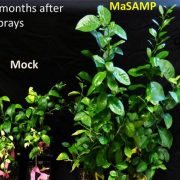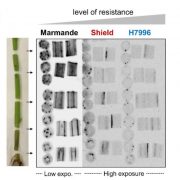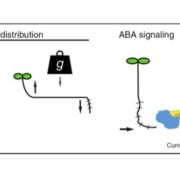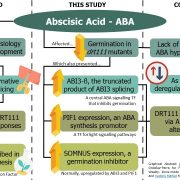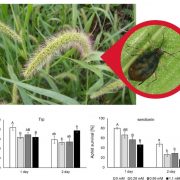Auxin synthesis contributes to virulence of Pseudomonas syringae (PLOS Pathogens)
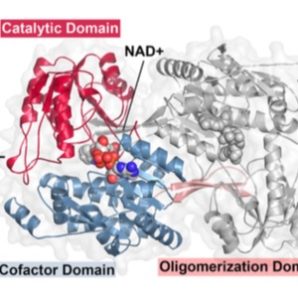 Plant pathogens have developed a large range of strategies to allow them to have successful interactions with their plant host, including physiological manipulation. For example, Pseudomonas syringae, the cause of speck disease in many plant systems, manipulates the auxin phytohormone physiology in its plant hosts. McClerklin et al. showed that P. syringae pv. tomato strain DC3000 synthesizes indole-3-acetic acid (IAA) via an indole-3-acetaldehyde intermediate. The researchers also identified the putative genes of PstDC3000 aldehyde dehydrogenase and performed a biochemical analysis of their corresponding protein, including the overall three-dimensional structure of indole-3-acetaldehyde dehydrogenase (AldA) and the structure of its active site. The use of DC3000 IAA biosynthesis mutants (ald mutants), which produce less IAA in culture in comparison with the DC3000 controls, showed that ald mutants exhibit reduced virulence on Arabidopsis thaliana, demonstrating that auxin contributes to virulence in P. syringae. Furthermore, the authors showed that pathogen-derived IAA suppresses salicylic acid-mediated defenses, while plant-derived IAA promotes pathogen growth, showing that IAA plays multiple roles during pathogenesis through different mechanisms depending on whether it originates in plant or pathogen. (Summary by Isabel Mendoza) PLOS Pathogens 10.1371/journal.ppat.1006811
Plant pathogens have developed a large range of strategies to allow them to have successful interactions with their plant host, including physiological manipulation. For example, Pseudomonas syringae, the cause of speck disease in many plant systems, manipulates the auxin phytohormone physiology in its plant hosts. McClerklin et al. showed that P. syringae pv. tomato strain DC3000 synthesizes indole-3-acetic acid (IAA) via an indole-3-acetaldehyde intermediate. The researchers also identified the putative genes of PstDC3000 aldehyde dehydrogenase and performed a biochemical analysis of their corresponding protein, including the overall three-dimensional structure of indole-3-acetaldehyde dehydrogenase (AldA) and the structure of its active site. The use of DC3000 IAA biosynthesis mutants (ald mutants), which produce less IAA in culture in comparison with the DC3000 controls, showed that ald mutants exhibit reduced virulence on Arabidopsis thaliana, demonstrating that auxin contributes to virulence in P. syringae. Furthermore, the authors showed that pathogen-derived IAA suppresses salicylic acid-mediated defenses, while plant-derived IAA promotes pathogen growth, showing that IAA plays multiple roles during pathogenesis through different mechanisms depending on whether it originates in plant or pathogen. (Summary by Isabel Mendoza) PLOS Pathogens 10.1371/journal.ppat.1006811


